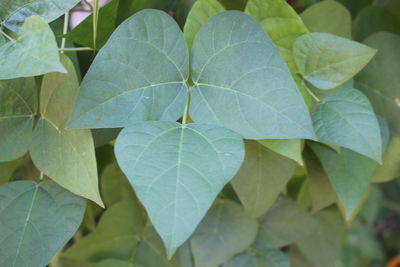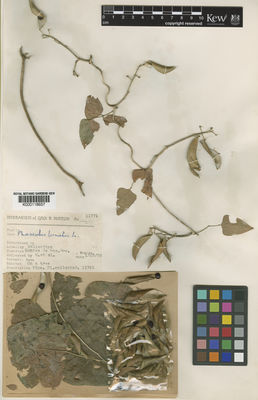Geography and distribution
Lima bean originated in the Neotropics and has two main centres of domestication. The small-seeded varieties were developed in Central America and the large-seeded types were cultivated in South America (mainly in Peru) as far back as 6,000 BC.
Following Columbus' 'discovery' of America, humans spread lima bean throughout the continent and it was subsequently introduced into Europe and Asia. Portuguese 'explorers' brought butter beans to Africa during the slave trade. Today lima bean is cultivated throughout the tropics.
Description
Overview: Phaseolus lunatus can either be an annual (completing its life-cycle in one year) or a perennial (living for several years) herb. Some forms of the species are erect with trailing branches while others are climbing vines up to four and half metres long ( occasionally up to 8 metres).
Roots: The roots can extend 2 metres into the soil and are either thin or swollen.
Leaves: The leaves are arranged alternately along the main stems and each leaf is composed of three leaflets, with the terminal leaflet held away from the two opposite lateral leaflets (the whole leaf being referred to as pinnately trifoliolate). The petiole (leaf stalk) can be from 1.5 to 19 cm long.
Flowers: The stalked flowers are clustered on small fleshy nodes along an unbranched axis (this a pseudoracemose inflorescence); the inflorescences are axillary (arising in the axilof the stem and the leaf petiole). The inflorescences are sometimes panicles, in which the main axis has several lateral branches. The flowers are white, pale green or rose-violet and papilionaceous (pea-flowered). Each flower has 10 stamens (male reproductive organs) 9 of which are fused into a partial tube or sheath and 1 free. The ovary (female reproductive organ) is about 3 mm long, and has a covering of minute hairs. The style has a terminal coil with a collar of hairs below the stigma (the female receptive organ where pollen is deposited by a visiting pollinator).
Fruit : The fruit is an oblong pod, 5-13 cm long and bears up to 5 seeds. The seeds are kidney-shaped to subglobose (almost spherical), up to 11 mm long, white, green, yellow, brown, red, purple, black or variously speckled.
Uses Food
In Africa, lima bean is grown mainly for its immature and dry seeds which are eaten boiled, fried or baked. In Nigeria, the seeds are commonly used in soups and stews, cooked together with maize, rice or yams. Some indigenous peoples, such as the Yoruba, process the seeds into porridge, puddings and cakes. The green, immature seeds, pods and leaves are eaten as a vegetable in Ghana and Malawi. Lima beans are cultivated on an industrial scale in the United States for canning and freezing. In many Asian countries the shoots and young plants are cooked and eaten. The leaves and stems of butter bean may be turned into hay or silage.
Medicinal
The plant has many medicinal uses. In Senegal and the Democratic republic of Congo the juice from the leaves is used in nasal instillations against headache and as eardrops. In Nigeria the seeds are pulverised and rubbed into small cuts or onto tumours and abscesses to encourage the discharge of pus. The seeds and leaves of butter bean are valued in traditional Asian medicine for their astringent properties and they are used as a diet to relieve fever.
Other uses
The seeds of lima bean are sometimes used to feed livestock, but there is a risk of hydrogen cyanide poisoning if used raw. The ability of lima bean to fix nitrogen from the air by way of bacteria housed in root nodules makes it a good soil fertiliser. For this reason it is often grown as a cover crop and for green manure.
Crop wild relatives of lima bean
The Millennium Seed Bank and the Global Crop Diversity Trust are engaged in a ten-year project, called 'Adapting Agriculture to Climate Change'. The project aims to protect, collect and prepare the wild relatives of 29 key food crops, including lima bean, so that they are available to pre-breeders for the development of new varieties that are more resilient to the effects of climate change.
Millennium Seed Bank: Seed storage
The Millennium Seed Bank Partnership aims to save plants worldwide, focusing on those plants which are under threat and those which are of most use in the future. Once seeds have been collected they are dried, packaged and stored at -20°C in Kew's Millennium Seed Bank vault.
Description of seeds: Average weight of 1,000 seeds = 571.0 g
Number of seed collections stored in the Millennium Seed Bank: One
Seed storage behaviour: Orthodox (the seeds of this plant can be dried to a low moisture content without significantly reducing their viability. This means they are suitable for long-term frozen storage)
Germination testing: Successful
This species at Kew
Pressed and dried specimens of Phaseolus lunatus are held in Kew's Herbarium, where they are available to researchers by appointment. Details and images of some of these specimens can be seen online in Kew's Herbarium Catalogue.







